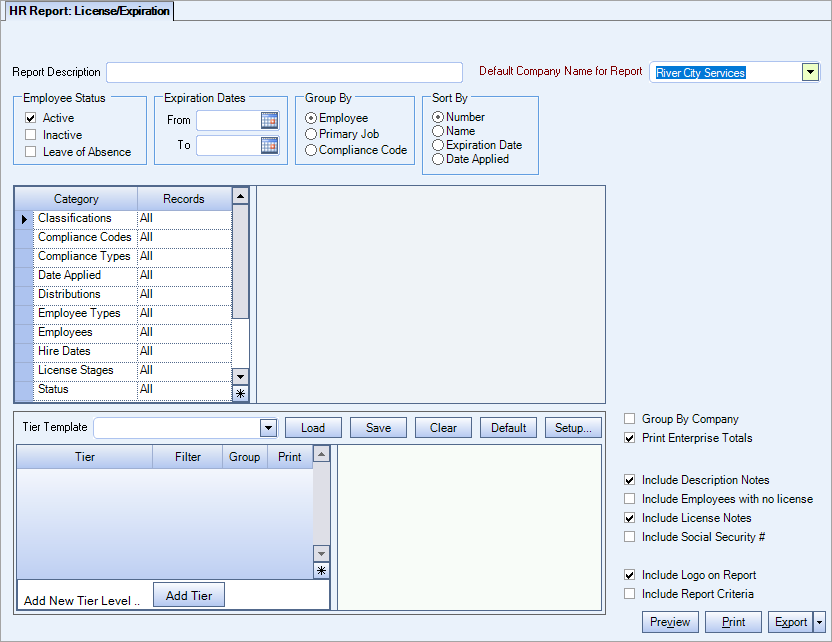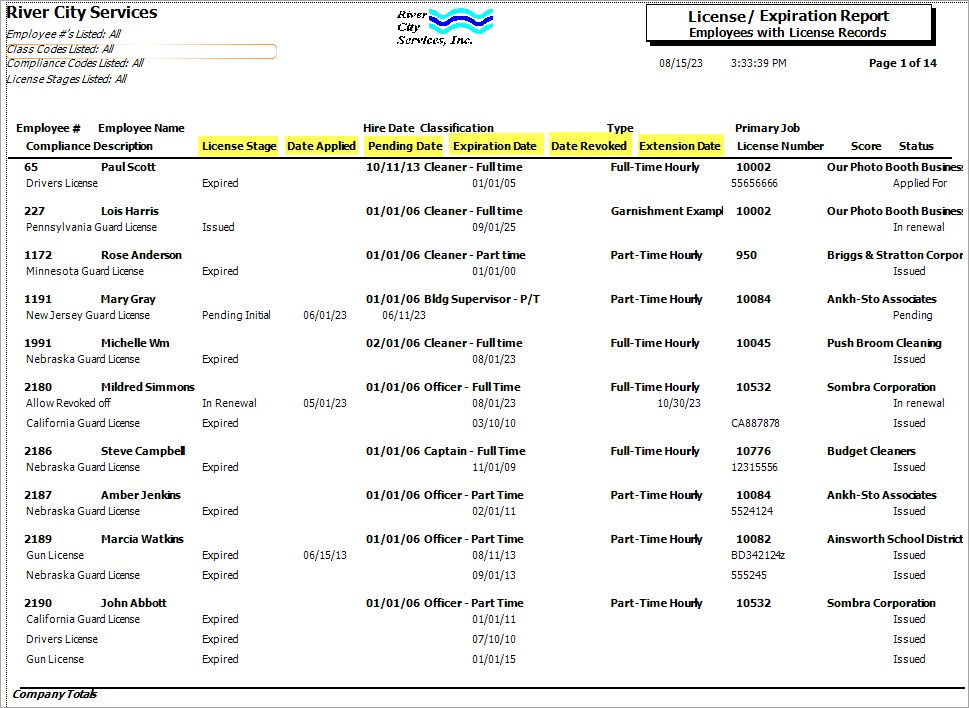Overview
The License/Expiration Report shows the information from the License/Expiration tab from the Compliance Tracking By Employee screen. Only those Compliance Codes that are set up with Due Dates Based On – “License / Expiration Date” will display on this report.
This report makes it easy to identify those employees whose License will be expiring if you run the report using an Expiration Date range. You can also identify those employees who do not have any license records.
You can filter, group, and print by Tiers, allowing for total customization of the report. To make filtering easier, for any Tier, you can include All, Pick/Create or Exclude parameters. Using Tier Templates to set up and save report templates makes it easy to generate a specific report each time you need it, without having to recreate the criteria. See Using Tier Templates for more information.
You may filter the report by Hire Dates, Classifications, Employee Types,Supervisors,Employees,Compliance Codes,Compliance Types, Status, Date Applied and Distributions.
You can group the report by Employee, Primary Job,or Compliance Code.
Note: In the grid view of the report, the Renewal Start Date is the Expiration Date (from the License/Expiration Codes window) minus the Renewal Lead Time (from the Compliance Tracking Codes window).
Security
The License / Expiration Report options screen belongs to the HR Report License/Expiration security group.
The HR Report License/Expiration Group is part of the HR Reports All Employees and the HR ALL groups.
For more information, see Learning about Security Groups.

Key Functionality
Type a description to name the report. This description prints above the Report Title.
The Default Company Name for Report is populated from the Company Setup screen. The list contains all companies for which you have security permissions to view. If you have permission for only one company, that will be the only one displayed in the list. If you have permissions to multiple companies, the list will display those companies PLUS the default reporting company.
When discernible, WinTeam will print the appropriate company name and logo on each page; otherwise the Default Company Name will print. That is, if a Company level is included in the tiered section and is displayed in the tiered information at the bottom of the page, then that company's Report Name and Logo (if selected) prints on that page.
If there is not a Company identified in the tier area of the page, then the Default Company Name for Reports is used. The default Company Name and Logo is also used for the Total Enterprise report. For more information see Learning about WinTeam Reports.
Employee Status
Use the Employees Status option to filter the report data by employee status.
- Select Active to include active employees on the report.
- Select Leave of Absence to include employees who are on leave of absence on the report.
- Select Inactive to include inactive employees on the report.
Expiration Dates
Use the Expiration Date range fields to identify those employees whose License will be expiring during a specific date range.
Important: If Expiration Date range is used as a filter, records with a blank or null Expiration Date are not included in the report. This affects the data that is returned in all versions of the report: Preview, Printed, and Exported.
Group By
Use the Group By option to group the compliance items by either Employee, Primary Job, or Compliance Code.
Sort By
Use the Sort By option to sort report data by Number, Name, Expiration Date, or Date Applied.
Category/Records
Classifications
Use the Classifications category to select the Classifications to include on the report.
Select All to include all Classifications.
Select Pick to define specific Classifications for the report. When you select Pick, the Classifications list displays. Select the check box next to each Classification to include on the report.
Compliance Codes
Use the Compliance Codes category to select the Compliance Codes to include on the report.
Select All to include all Compliance Codes on the report.
Select Pick to define specific Compliance Codes for the report. When you select Pick, the Compliance Code list displays. Select the check box next to each Compliance Code to include on the report.
Compliance Types
Use the Compliance Types category to select the Compliance Types to include on the report.
Select All to include all Compliance Types on the report.
Select Pick to define specific Compliance Types for the report. When you select Pick, the Compliance Types list displays. Select the check box next to each Compliance Types to include on the report.
Distributions
Use the Distributions category to select the Distribution to include.
Select All to include all Distribution types.
Select Pick to define specific Distribution to include. When you select Pick, the Check Distributions add edit list displays. Select the check box next to each Check Distribution to include.
Employee Types
Use the Employee Types category to select the Employee Types to include.
Select All to include all Employee Types.
Select Pick to define specific Employee Types. When you select Pick, the Employee Types list displays. Select the check box next to each Employee Type to include.
Employees
Use the Employees category to select the Employees to include on the report.
Select All to include all Employees on the report.
Select Range to define a range of Employees for the report. Type the beginning Employee Number in the From field and the ending Employee Number in the To field.
Select Create to define your own list of Employees. When you select Create, a small grid displays to the right. Enter the Employee Numbers you want to include in the list, or use the Lookup to locate the Employee Numbers.
Select Exclude to identify records that should not be included. When you select Exclude, a small grid displays to the right. Enter the Employee Numbers you want to exclude in the list, or use the Lookup to locate the Employee Numbers.
The Hire Dates Category is used to filter the employees to include on the report based on Hire Dates.
Select All to include all employees, regardless of the Hire Date.
Select Range to define a range of Hire Dates for the report. When you select Range, the range fields display. Type the beginning date in the From field and the ending date in the To field.
Status
Use the Status category to filter by the License Status (Applied For, Issued, Pending).
Select All to include all Status' on the report.
Select Pick From List to define specific Status' for the report. When you select Pick From List, the Status list displays. Select the check box next to each Status to include on the report.
Supervisors
Use the Supervisors category to filter the report by Supervisors.
Select All to include all Supervisors.
Select Pick to select the Supervisor(s) to include.
Use the Tier Template to define and save customized settings for a report. To use an existing template, select the template from the list and click Load.
To create a new template, you can load an existing template, make the necessary modifications, click Save, and define a new template name in the Save As dialog box. Alternatively, you can start with a blank template by clicking the Clear button.
To modify an existing template, load the template, make the necessary modifications, and then click Save. The name of the existing template display in the Save As dialog box. Click OK.
For more information see Using Tier Templates and Using Tier Parameters.
This option is available to users who have more than one company, but is not selected by default. If selected, the default company prints on the Grand Total Page and the Report Criteria page. All other pages print the applicable company name. If not selected, the default company prints on every page of the report.
The Print Enterprise Totals check box is available to users who have more than one company, and may be selected to print enterprise totals on the report. This check box is selected by default.
If this is not selected, the report prints only the tiered reports that are marked for printing.
The Print Company Totals check box is available to users who have only one company, and may be selected to print company totals on the report.
Include Description Notes
Select the Include Notes check box to include Notes from the Compliance Tracker Codes screen.
Include Employees with no license record
Select this check box to include employees on this report who do not have a license record.
Include License Notes
Select the License Notes check box to include Notes from the Compliance Tracker by Employee (License / Expiration Codes tab) screen.
Include Social Security #
Select this check box to include employee social security numbers on the report.
Select this check box to print the company logo on the report. It is selected or cleared by default based on the option selected in SYS:Defaults. However, you can modify the setting on each report.
Select this check box to include a list of the report options selected for the report. The Report Criteria page includes any ranges specified and each Category/Record selection made for the report. This check box is cleared selected by default.
Preview
Click the Preview button (or use the shortcut key, ALT + V) to view the report before printing.
Click the Print button (or press ALT + P) to send the report to your default printer.
Export
Click the Export button (or press ALT + X) to export the report to a specified format. Reports may be exported to Adobe Acrobat (PDF), Excel, Comma-Separated Values (CSV), Grid View and E-mail (available for premise-based clients only).
Report Sample

